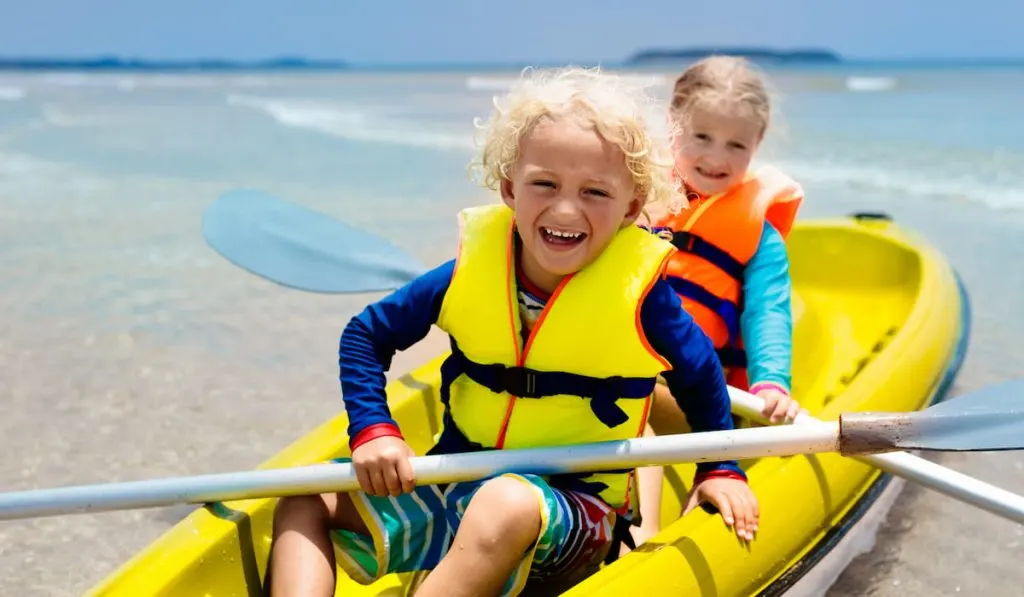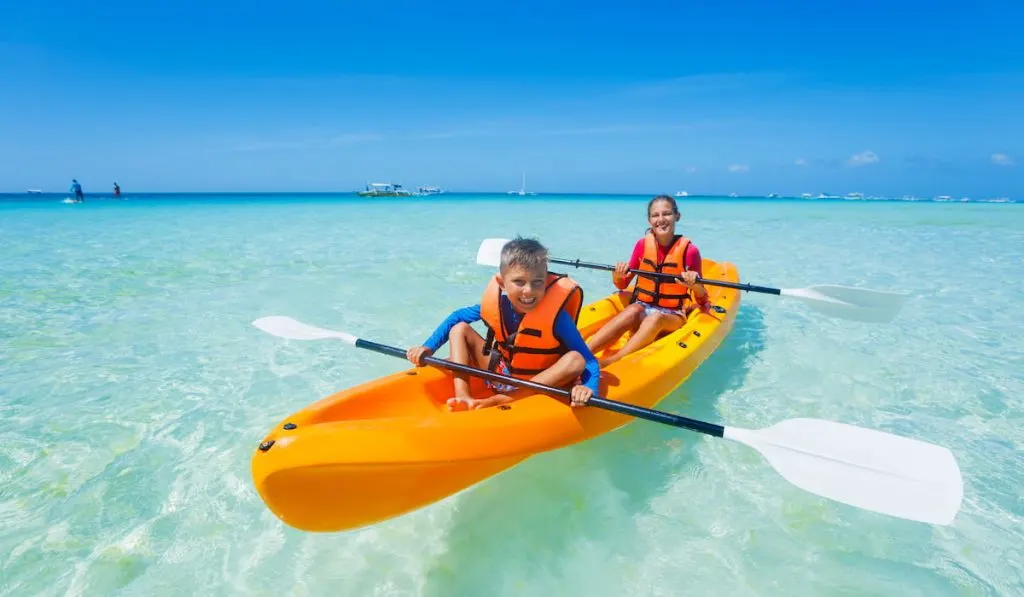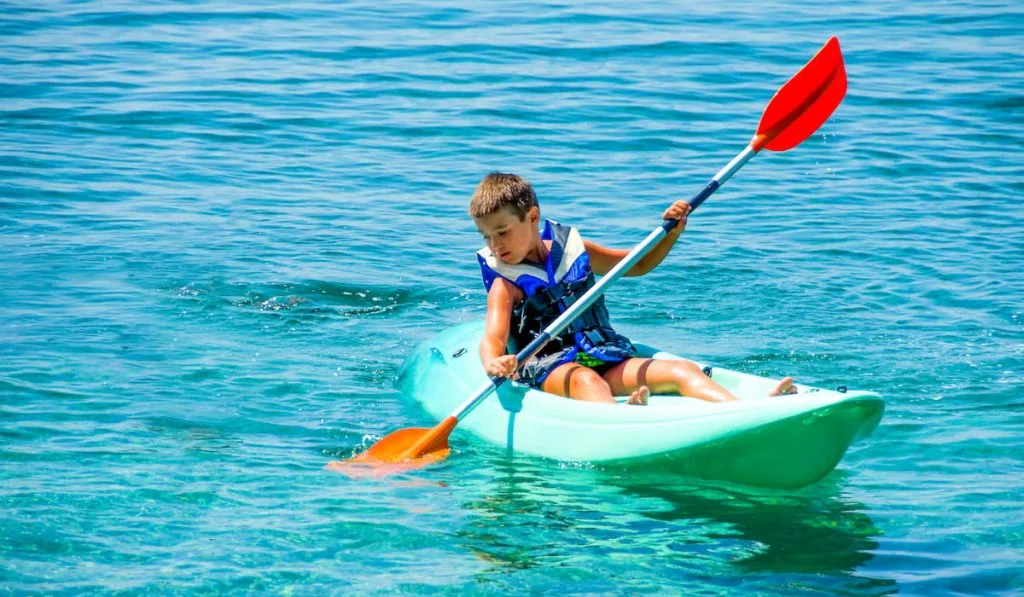The story goes the same for most people. You start looking for something to do on the weekend. Something that will get you outside and moving when you have some free time.
After some searching online and a few trips to the store, you settle on a kayak. After a few trips on the river or around the lake, you’re hooked!
Now you want to share kayaking with the entire family. You’ve got kids who are begging to come along. Sure, there are tandem kayaks you can use to tote smaller kids around, but at some point you want them to get out and start paddling on their own.
There are a lot of choices when it comes to choosing a kayak for a child. Making the right selection will make kayaking more fun for your kid and keep them kayaking for years.
Here’s some helpful information to help you make the best purchase and get your kid the best kayak possible. With the right kayak, your kids will be safe on the water and you’ll have years of great family fun.

Can Your Child Paddle Solo?
Kayaks come in all sizes. No matter how old your kid is, odds are you can find a kayak that’s suitable for their height and weight (obviously except for toddlers, etc.). The real question you have to ask yourself is whether your child will be able to paddle on their own and for how long?
Buying them their own kayak won’t help much if they want to stop and get out after five minutes. Most likely, you’re going to waste money if you buy a kayak for a child who is too young.
When they are small enough, you may be able to let them sit on your lap and paddle for a bit. If you have a tandem, it’s a great way for them to learn how to paddle before they go out on their own.
Once they’re big enough to paddle, then you have to start thinking about what you want to accomplish on the water. If you’re just looking for a fun time at the lake, then a kayak for a child is a terrific idea. They can stick close to the shore and paddle as much or as little as they’d like.
Eventually, they will build up endurance and will want to go further and faster along with the adults.
Decide on a Price Range
Unless you’re fortunate enough to not have to worry about money, then cost is a consideration for your child’s kayak. Remember, your kid isn’t going to be small forever, so this is probably only a temporary solution to your desire to have them join in on the family hobby.
They’ll get too tall and heavy for their child’s kayak and you’re going to be back shopping before you know it. Find something that’s relatively affordable and within your budget.
For smaller kids, kayak manufacturers do a good job of limiting features to keep them fairly basic because they know cost is a concern. They don’t want to price families out.
Businesses also know that making child kayaks affordable is the best way to build a passion for the sport and secure long-term customers who will buy more kayaks down the road. Typically, child kayaks will have fewer hatches and other features.
As you move into adolescent kayaks, you’re essentially dealing with the same thing as adult kayaks with a full set of features. They may be a bit cheaper than adult kayaks, but not by much.

Finding the Right Fit
Just like with adult kayaks, child kayaks come in either open tops or covered models. A lot of families like to buy kayaks with open tops because kids want to jump in the water and play. They can hop in or out of their kayak more easily and won’t feel as restricted.
Another benefit of an open-top kayak is that it’s impossible for them to get swamped. They don’t take on a lot of water, and, when they do it’s not really an issue.
Sit-in designs are better for high-performance kayaking that help kids work on their paddling skills. If you’re tackling some rapids or going down rivers, then sit-ins will keep them safe and are usually easier to maneuver. So, which one you buy depends on what you want to do with your family.
Are you playing at the lake on a Saturday? Then you probably want to go with an open top. Are you interested in getting serious about the sport? Then you may want to opt for a sit-in kayak.
Generally, your child’s legs should fit comfortably in the kayak. You don’t want them to feel cramped because then it will be uncomfortable after an hour or two. If it’s too big, then it will be hard for them to pivot. Get something roomy but not too roomy.
You’ll usually be able to buy a child’s kayak for your children until they reach over 100 pounds. Once they weigh that much, they are going to have a hard time fitting in a child kayak. They’re most likely better off in a small adult kayak and can size up from there.

Take a Look at the Store
People buy almost everything online these days, but when you’re spending money on something like a kayak, it can pay off to go to the store to try something out.
Most kayak companies make at least one model designed for children, and you will likely be able to find them at a larger local sporting goods store or a specialty kayak store in your area.
Take your kid there, talk to an associate, and measure their height to see what size kayak will work best. You can buy something on the spot there or go home and compare prices once you know how big you have to go.
Remember to Buy Child Safety Gear
The kayak isn’t the only thing you have to buy in child sizes. Finding the right safety gear is just as important, if not more important, than the kayak itself.
Of course, you’re going to want a life vest that fits your child no matter if they are an expert swimmer or if they struggle in the water. The first few times on the kayak, your kid is probably going to end up in the water at some point.
Make sure they have something that can keep them afloat. The same thing goes for helmets and other gear. Measure them for the right size, and buy the appropriate gear. Don’t just grab something from the garage and toss it on them before they start kayaking.
Paddles aren’t exactly safety gear, but the wrong paddles can certainly be dangerous. Don’t fall for the temptation of buying cheap adult paddles for your kids. Those are going to be too long and will likely be too heavy for them to use well.
It can end up getting them in trouble on the water. Getting a higher-end paddle designed for children will keep them safe and will be the best paddling teacher you can buy.

Think About a Tow Rope
Many child kayaks have attachments where you can tie a rope to their kayak and tow them along. This is a fantastic solution for parents who want to encourage kids to paddle on their own, but don’t want to ruin the day if a kid is not in the mood and is stubborn enough to sit there without moving for hours.
The last thing you want is to get halfway to your destination and then have one of your children refuse to keep paddling.
Buy Basic First – Build From There
A lot of parents waste thousands of dollars every year because they want their kids to love what they love so badly. Whether you’re a golfer buying clubs for your kid or you want them to be passionate about college football like you are, it’s tough to make kids love something they don’t.
If you’re in the market for your child’s first kayak, just remember that they may end up hating it! They may not want to get off their video games and spend hours paddling around a lake with mom and dad.
Your best bet is to buy a child kayak with basic features so you don’t waste hard-earned money on a hobby your kid has no interest in. Odds are, your kid isn’t going to know the difference between a basic kayak and a fancy kayak outfitted with modern features.
They’ll do just fine as long as everything works and fits them properly. Once they start loving kayaking as much as you do, then you can invest a bit more on their next kayak, and reward them with buying nicer helmets, flotation devices, paddles, and other gear.
You have a lot of choices around what child kayak to buy. Keep your budget in mind and size it right for your kids. Take things slowly and realize that, in all probability, you’re going to be buying more than one kayak for them as they grow.
Now get out there and have some fun with the family and get your children feeling great in their new kayak!
